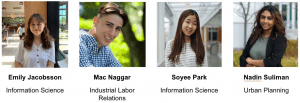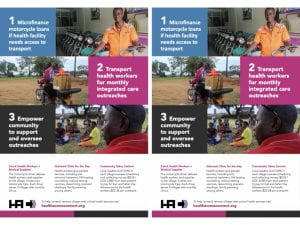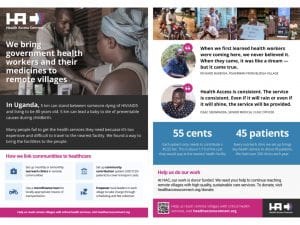What is Health Access Connect?
Health Access Connect (HAC) is a non-profit devoted to providing healthcare services to remote villages across Uganda by encouraging community-run outreach programs. Specifically, HAC organizes “health outreach events,” in which HAC helps to bring qualified health professionals to remote villages across Uganda. HAC effectively solves the “last-mile-problem” that has prevented proper health care services from reaching remote villages in Uganda for decades. To do this, HAC uses unique tactics such as microfinancing of “medi-cycles” as well as sourcing other forms of transportation so that health officials are able to reach remote villages. As part of StudioLab, we were able to utilize concepts learned in class to bolster and enhance HAC’s story. The following report depicts our journey throughout the Fall 2021 semester to deepen our understanding of transmedia knowledge development in the real world and help HAC change Uganda for the better.
Design Challenge
“Health Access Connect wants to communicate a meaningful message through their two-page flyer, strategically plan their end-of-year fundraising campaign in order to improve engagement, reaching donors for funding, and maximize their limited resources.”
Design Team

Our Process
-
Hear Phase – Attempting to understand this design challenge to the fullest extent
-
Deliverables Understanding – Understanding the technicalities of each deliverable and how executing on these technicalities would bring us closer to achieving our mission statement
-
Create Phase – Taking our understanding of the design challenge from the “Hear” phase and reframed and “transmediating” this design challenge into tangible deliverables.
-
Deliverables – The “Deliver” phase is where our team moved from ideas and prototypes to solutions and plans that could be actually implemented.
1) Hear Phase:
At the beginning of the semester, we met HAC for the first time and began fleshing out their “design challenge.” A “design challenge” can be best understood as the design obstacle that distracts HAC from progress towards their goals. In the “Hear” phase, we are attempting to understand this design challenge to the fullest extent.

“Hear,” Emphasize, and Conceptualize”
Initially, our team met with HAC team members, Kevin and Mercy, to hear and empathize with their stories. To better ideate off this information, we aimed to move from a place of low resolution to higher resolution by looking at this information through different design frames.
First, we generalized our design challenge through an exercise guided by the sparkline design frame where we brainstormed different “What Is” and “What Could Be” scenarios. In addition, we identified four main stakeholders: donors, HAC volunteers, health workers, and remote Ugandans (without access to health care).
CAT Frame – End of the Year Campaign Schedule
- Conceptual: Schedule detailing HAC end of year campaign schedule ● Aesthetic: messy, overcrowding text, lacking clarity
- Technical: Google Docs
Logos/Pathos/Ethos – 2 pager
- Logos: provides statistics on HIV and the remoteness of some Ugandan villages, breaks down costs and expenses of serving as an NGO
- Pathos: doesn’t appeal to the emotional aspect as much, lacks testimonials or personal anecdotes
- Ethos: emphasizes collaboration with community health care professionals
Victor’s 3 Tier Framework – 2 pager
- Interactive: lacks call to actions like QR code or social media, only has website ● Visual: interesting visuals, helps to see the real life people who HAC is impacting ● Symbolic: uses diagram of figures representing the groups (who HAC serve) who are most at risk for HIV
2) Deliverables Understanding
After conceptualizing and looking at the “Hear” phase through multiple lenses, we brainstormed how to narrow down our design challenge: “Health Access Connect wants ___________ in order to ______________.” We used sticky notes again to help us collude ideas around our mission for the project. Then, we grouped each statement with similar themes to converge on a focused mission statement.


3) Create Phase
Our team then moved to the “Create” phase of Human Centered Design in which we took our understanding of the design challenge from the “Hear” phase and reframed and transmediated this design challenge into tangible deliverables. Furthermore, this conductive leap of thought has led our team to create two forms of transmedia prototypes that are able to meet the specific wants and needs of the Health Access Connect team: a two-pager, and a campaign fundraising schedule.
UX Design Frame
Once we did research on how to become a creator and what qualities to instill in our transmedia prototypes, we sought a framework to actually start building. The framework we decided to use was the UX Design Framework. UX Design is all about creating the best experience of your prototype for your stakeholders (In fact, ‘UX’ in the UX Design Framework stands for “User experience.” In the real world, UX design appears everywhere. Our team was actually able to experience the essence of UX design during an in-class workshop. We observed how UX design plays a role even in the architecture of Cornell classrooms and libraries. There are three main pillars of the UX Design Framework. First is experience design which is concerned with the cognitive, affective and visceral impact on the stakeholders. Second is the information architecture which is concerned with the structure of information and experience. Lastly, is the information design which is the look and the feel of individual moments of the prototype.
Our Transmedia Prototypes
Pairing the UX framework with the lessons we learned from our research on creators, we came up with themes for our transmedia prototypes:
- Experience Design: grassroots, impactful, call to adventure… then call to action
How we implemented this into our transmedia prototypes: Two Pager: adding eye-catching, emotionally poignant images from grass roots campaigns in Uganda that calls to adventure, then calls to action when explaining HAC needs funding to continue. Campaign Schedule: including actionable outreach items and creating a campaign strategy that emphasized involvement
- Information Architecture: objective, clearly-outlined, Figma-designed 2-pager, and Campaign Schedule that can serve as a platform for collaboration and thought expansion
How we implemented this into our transmedia prototypes: Two Pager: create own proprietary two-pager framework that clearly segments images, information, and graphs to incentivize calls to actions (mainly to donate). Campaign Schedule: use Monday.com to serve as a Product Management platform where HAC volunteers can be assigned specific outreach strategies
- Information Design: digestible, informative
How we implemented this into our transmedia prototypes: Two Pager: only include information that can be easily understood that aligns with the message of HAC, ex. Simple graphs, clear pictures, concise text. Campaign Schedule: simple action items assigned to Cornell team and HAC team, removing the need for prior experience of outreach/marketing
4) Deliverables
After our “Create” phase, we were ready to move onto the “Deliver” phase of the IDEO’s Human Centered Design Framework. The “Deliver” phase is where our team moved from ideas and prototypes to solutions and plans that could be actually implemented. The “Deliver” phase also helped us to create a learning plan to measure and continue iterating in our designs.
Two-Pager Deliverable
This final two pager started off as low resolution, existing just as a desire and examples that aim to improve the aesthetic consistency and messaging of the old two pager. By using conceptual frameworks including the CAT frame, Logos/Pathos/Ethos, and the UX framework, we were able to take this idea and re-iterate through many stages to create a product that can be sent to donors, given out at outreach events, and promoted through fundraising campaigns. We provided HAC these files so they can continue iterating after our team’s work.



Campaign Fundraising Schedule
During the “Create” phase, we brainstormed a lot of outreach strategies and workflow techniques that we thought could be seamlessly executed. However, with prototypes, we failed to consider the real-world implications that have to be confronted during a real fundraising campaign. To bring our campaign fundraising schedule/outreach to the real world we had to confront the following issues:
- Time differences between team in US and team in Uganda
- Differing levels of ability/dedication to stick to plan
- Coordinating specific outreach deliverables
- Time crunch between Cornell schedule and campaign schedule


To overcome these issues, we realized that we needed to re-iterate our campaign schedule towards more realistic expectations. We needed outreach strategies that could be automated in a way that required very little coordination between teams and only relied on our own preparation to actually produce and schedule the outreach deliverables.
This resulted in us creating a three-staged campaign fundraising schedule:
1. Phase One: Create (Oct 25-31)
During the Create phase, we focus on developing all the outreach deliverables that will be automated during the campaign.
2. Phase Two: Awareness (Nov 1 – Nov 29)
During the Awareness phase, we plan to automate and send out outreach materials that bolster awareness of the campaign that is set to start on Nov. 30.
3. Phase Three: Execute (Nov 30 – Dec 30)
In the Execution phase, we plan to automate and send out outreach materials that encourage donations during the campaign. We used a service called ClickUp to transparently schedule each of these phases and their corresponding deliverables. Clickup allows all members to be assigned to a specific deliverable. This functionality helped us build out each phase asynchronously without having to coordinate workflow as a team.
 Outreach Deliverables
Outreach Deliverables
In the past, HAC’s fundraising outreach has been based on generic social media posts and emails to past donors, friends and family. We want to revolutionize HAC’s outreach by using more personalized and immersive forms of media. To do this we plan to reach out to stakeholders with engaging social media content and interactive emails. We hope that this might help HAC reach new audiences and opportunities they may not have been aware of.


Final Presentation
At the end of the term, we presented our work to the classes other teams and partners via Zoom, sharing the design process and deliverables and reflecting on the collaborative experience. We recorded it on video.
.

